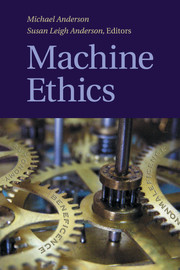General Introduction
Published online by Cambridge University Press: 01 June 2011
Summary
The subject of this book is a new field of research: developing ethics for machines, in contrast to developing ethics for human beings who use machines. The distinction is of practical as well as theoretical importance. Theoretically, machine ethics is concerned with giving machines ethical principles or a procedure for discovering a way to resolve the ethical dilemmas they might encounter, enabling them to function in an ethically responsible manner through their own ethical decision making. In the second case, in developing ethics for human beings who use machines, the burden of making sure that machines are never employed in an unethical fashion always rests with the human beings who interact with them. It is just one more domain of applied human ethics that involves fleshing out proper and improper human behavior concerning the use of machines. Machines are considered to be just tools used by human beings, requiring ethical guidelines for how they ought and ought not to be used by humans.
Practically, the difference is of particular significance because succeeding in developing ethics for machines enables them to function (more or less) autonomously, by which is meant that they can function without human causal intervention after they have been designed for a substantial portion of their behavior.
Information
- Type
- Chapter
- Information
- Machine Ethics , pp. 1 - 4Publisher: Cambridge University PressPrint publication year: 2011
Accessibility standard: Unknown
Why this information is here
This section outlines the accessibility features of this content - including support for screen readers, full keyboard navigation and high-contrast display options. This may not be relevant for you.Accessibility Information
- 2
- Cited by
